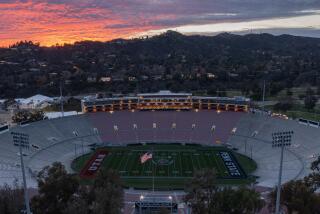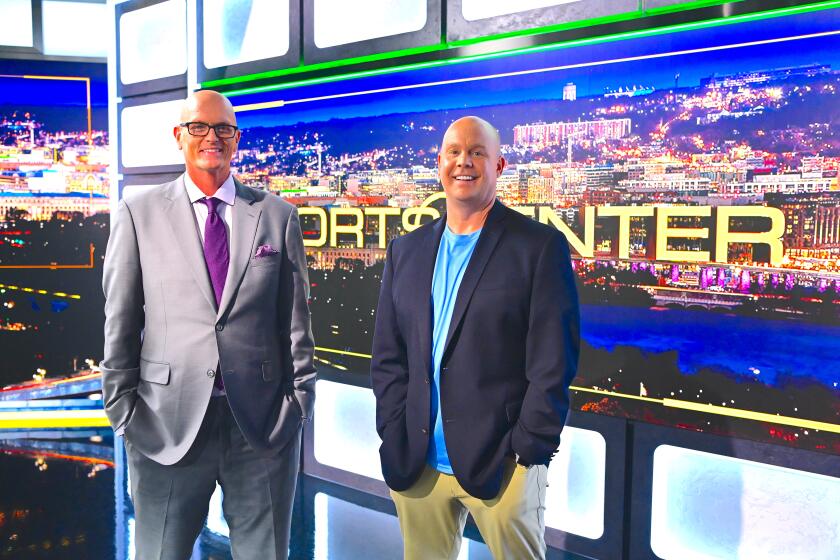Tournament of Roses logo’s controversy
Competition is at the heart of the annual Tournament of Roses, with millions tuned in to see which parade floats will be judged the best, and which team will win the Rose Bowl.
Unknown to the viewing public, a strange competition took place behind the scenes from 2007 until mid-October, over who designed the Tournament logo that has been in use for 29 years to symbolize, promote and adorn the parade and the football game.
Emblazoned as a trademark on all manner of merchandise, the stylized rose helps the nonprofit tournament earn more than $1 million a year in licensing fees. With federal courts in Santa Ana and San Francisco as a battleground, David Bartholomew tried to prove that he deserved payment as the logo’s true designer, claiming he drew it in 1977 for a class assignment at Pasadena’s Art Center College of Design.
Bartholomew contended that Susan Karasic, the officially acknowledged designer credited with having created the logo at the same school in 1981, must have taken it from drawings that he and a now-dead professor turned over to tournament officials during the spring of his senior year. But he never got to submit a single piece of evidence. Trying to represent himself because he couldn’t afford a lawyer, the career advertising designer and stained-glass artist attempted two suits in U.S. District Court, only to have both dismissed on procedural grounds. His two appeals likewise failed.
By the time Bartholomew brought his initial case in 2007, his career, which had included high-profile stained-glass projects at the Disney resort in Orlando, Fla., and the MGM Grand in Las Vegas, had been on the shoals for years after a late-1990s divorce.
Had it gone forward to a trial, Bartholomew and Karasic, a Los Angeles-based freelance Web designer, both could have mustered trenchant evidence. Hers would have been much more plentiful.
Karasic’s former professor and a platoon of Art Center alumni from her senior design class would have testified about a required project the students undertook in the fall term of 1981: vying against one another in a competition to create a logo for the Tournament of Roses. The process took several weeks, with students examining and critiquing one anothers’ efforts along the way.
“She developed the whole thing right in front of us,” said classmate Vince Peterson, who is echoed by several other former students interviewed by The Times. “I saw the evolution, putting it together and fine-tuning it. Susie is a very strong designer. There’s no reason in the world why she would need to plagiarize. I think [Bartholomew] is confused.”
Bill Flinn, interim executive director of the Tournament of Roses, said he was part of the logo selection team and “went back and forth with Susie” early in 1982 as she made requested adjustments to the preliminary design that had won the competition.
Karasic, who voices her outrage over Bartholomew’s accusation quietly but firmly, could have shown jurors her large, black, cardboard-bound project portfolio, which documents how her winning concept evolved over dozens of sketches — from a realistic drawing of a long-stemmed rose, to the stylized image that became the logo. The breakthrough, she said, was deciding to enfold most of the flower in a circle, enabling it to work well on official stationery, on tiny souvenir lapel pins, or 10 yards wide on the Rose Bowl football field. Her prize was a pair of tickets to the 1983 Rose Parade and Rose Bowl. She took her mom.
But Bartholomew would have gone to court with serious ammunition of his own. His key eyewitness is Steve Lomas, with whom he shared a one-bedroom apartment in Glendale in 1977-78. Lomas says they used to do their Art Center course work in the living room they’d converted into a studio with back-to-back drafting tables.
“I definitely saw him working on that rose. I know for a fact that he designed that logo,” said Lomas, a former Art Center film instructor who now does digital media design in Nashville. Lomas says he’d been out of touch with Bartholomew for at least 10 years until late 2009 or early 2010, when his old friend sent him an email. It contained about a dozen different, unidentified rose images that over the years had been connected with the tournament. Bartholomew asked Lomas whether any of them looked familiar.
“I said, ‘No, just the one you did,’ and I pointed it out,” Lomas said. Another friend and Bartholomew’s ex-wife said they remember him working on the rose design, but couldn’t recall how it looked.
Bartholomew’s other key evidence would have been a pencil drawing on tracing paper with a yellowed piece of white tape attached. He says he made it in 1977 when he and a handful of other students in one of his courses were coaxed into an informal class competition to create a rose that could be painted at midfield of the 1978 Rose Bowl game. Bartholomew says the tracing paper drawing is his final working draft. On it, markings and notations in ink call for eliminating two leaves. With that change, the result would be almost identical to what’s now the tournament’s logo.
A note on the back of Bartholomew’s tracing paper drawing says “meet Leachman Follis on Mon.” He says it’s a reminder to keep the appointment during which he and his instructor, John Follis, gave his finished rose drawings to Lathrop Leishman, the tournament executive known as “Mr. Rose Bowl.” Follis and Leishman are dead, as is Don Kubly, the Art Center president who Bartholomew said urged Follis’ class to enter the competition. Bartholomew says his rose was picked as the class’ submission but was not used, and that the drawings he submitted were never returned.
Neither a football fan nor a parade buff, he says he paid no further attention to the tournament and didn’t become aware of its logo until December, 2005, when he saw it on the Internet. In 2006, he approached Tournament officials, saying the logo was his and he wanted to be paid. Asked for proof, Bartholomew turned to his alma mater to help him find eyewitnesses — his long-forgotten fellow-students from John Follis’ class. In March, 2007, Art Center’s attorney emailed Bartholomew, saying the school wouldn’t cooperate without a subpoena.
Thus began the strange journey through the courts that has left Bartholomew obsessed, embittered, and owing $14,625 he doesn’t have, because of sanctions U.S. District Court Judge Cormac Carney levied after declaring Bartholomew a “vexatious litigant.” Bartholomew had continued filing fresh pleadings and trying to buttonhole witnesses, even after Carney had dismissed his case on statute of limitations grounds.
Bartholomew has little money, works part-time as a night watchman at a senior citizen home and recently has battled rectal cancer. He shares a cluttered one-bedroom apartment in Dana Point with a roommate. A look into the court files reveals many long, rambling, hard-to-follow submissions that fail to address the technical legal issues posed by his opponents. They serve as ample proof that attempting to represent himself in a federal claim for copyright violation was a task Bartholomew was ill-equipped to undertake.
Then, again, making this a federal case wasn’t exactly Bartholomew’s idea. He had something much simpler in mind. Because Art Center officials said they would not turn over his 1977 classmates’ names without a subpoena, Bartholomew filed a small claim in Orange County Superior Court. He would get the subpoena, secure the names, then track down his long-lost classmates to provide eyewitness accounts he could give to tournament officials to back his demand for payment.
The small claims filing form requires plaintiffs to briefly state the nature of their beef. Bartholomew wrote that he was suing for copyright infringement. Copyright law, however, falls solely under federal jurisdiction, and Art Center’s attorneys immediately had the case transferred to U.S. District Court in Santa Ana. There, they moved for a dismissal on the grounds that a three-year statute of limitations had long run out. Carney agreed, deciding that Bartholomew should have sued no later than the mid-1980s. Bartholomew tried to appeal, but the Ninth Circuit denied it in 2010, saying he had missed the filing deadline by more than a year. Bartholomew says he tried to file papers inside the deadline, but the clerk of the appellate court kept rejecting them because they didn’t follow required formats.
Bartholomew said it was clear to him that the statute of limitations should not have been applied, because the copyright violation he alleged was continuous and ongoing. But he lacked the legal acumen or the writing skills to argue that point effectively in court pleadings.
In fact, said David Nimmer, a copyright attorney and UCLA law professor whose book, “Nimmer on Copyright” is considered a standard text, the Ninth Circuit Court of Appeals has held repeatedly that there is “a rolling statute of limitations” if a disputed copyright is still in use. All that’s limited, Nimmer said, is how far back a plaintiff can go in claiming damages for the copyright’s unauthorized use — the law won’t allow compensation for violations that took place more than three years before a suit was filed. But any subsequent violations are fair game.
Carney cited Roley versus New World Pictures, a 1994 decision by the Ninth Circuit Court of Appeals, as the basis for his decision to dismiss Bartholomew’s suit for failing to meet the statute of limitations. Ironically, it’s the very case in which Ninth Circuit judges clearly set down the “rolling statute of limitations” concept noted by Nimmer: “In a case of continuing copyright infringements, an action may be brought for all acts that [occurred] within the three years preceding the filing of the suit.”
Bartholomew filed a second suit in 2008, this time naming the tournament as the lead defendant, and Karasic as well. He tried to find a lawyer who’d take the case on contingency, but he says the ones he talked to steered clear, saying the outcome of his initial suit had created a “res judicata” — legalese for a done deal that can’t be undone. Carney dismissed this case as well, citing both statute of limitations and “res judicata.” There could be no case, the judge found, because the matter already had been decided in the Art Center case that had begun as a small claim.
This time Bartholomew managed to file his appeal on time. But on Oct. 13, a three-judge panel of the Ninth Circuit upheld Carney, writing that “the district court properly dismissed Bartholomew’s action as barred by the doctrine of res judicata.” The appellate judges said nothing about the statute-of-limitations issue. They also affirmed Carney’s decision to impose monetary sanctions because of Bartholomew’s “vexatious” conduct as a litigant, and they rejected Bartholomew’s claim that Carney had been biased and should have recused himself.
Bartholomew is convinced he’s the victim of a conspiracy to protect the logo, involving Art Center, the Tournament of Roses and Carney. The judge was a star pass receiver for UCLA, and played in the 1983 Rose Bowl game, running back and forth across the new logo on the day of its national television debut.
Lomas, Bartholomew’s former roommate and key witness, wonders why he has persisted. “He’s just too focused on it. He’s a really talented guy, but he seems bitter that his life hasn’t turned out the way he thought. For him this is personal, that’s real clear. I would have cut my losses a long time ago.”
If Bartholomew had gotten his day in court, there would have been at least one obvious gap in his case: He said that Kubly, the Art Center president, had access to his drawings, and that he himself gave drawings to tournament officials. There is no evidence, however, only supposition, behind his contention that someone from Art Center or the tournament must have held onto the 1977 drawings, then fed them to Karasic four years later to copy.
Karasic said she was shocked when Bartholomew called her in 2007, demanding payment. “He said, ‘This is my logo, not yours.’ It made no sense to me. I still don’t understand it. Had he designed something years before that was similar? It was kind of like ‘The Twilight Zone.’”
The Times shared an image of Bartholomew’s tracing paper drawing with her. “It looks like a tracing of my work,” Karasic said. “I can’t believe that it was legitimate.” She said she doesn’t consider Bartholomew dishonest, but believes he truly has convinced himself that her rose was his work.
Karasic said that when Bartholomew named her as a defendant in his second suit in 2008, she was eager to defend her integrity in court. But after spending $25,000, she said, she took her lawyer’s advice that getting the suit dismissed on procedural grounds was the way to go — legal fees for a trial might exceed $100,000.
Could this dispute rise from an improbable coincidence? In 1983, a Chicago jury found that the Bee Gees had stolen the melody of “How Deep Is Your Love?,” a hit from the 1977 film “Saturday Night Fever,” from an Illinois bar musician. But the judge rejected the verdict, ruling there was no evidence that the band had heard the unknown musician’s song. Tapes showed the Bee Gees painstakingly crafting a melody of their own that coincidentally matched the plaintiff’s.
In the design world, a famous case of duplication concerns the “N” logo the NBC television network rolled out in 1976 — only to learn that an identical one, formed by two trapezoids, already was being used by the Nebraska Educational Television Network.
Because logos need to be simple, coincidental or unconscious duplication is “something we graphic designers tremble about all the time,” said Mari Hulick, head of communication design at the Cleveland Institute of Art. But she and Bill Newkirk, a dean and former head of graphic design at Rhode Island School of Design, said coincidental duplication is a very tenuous explanation when the designers worked in the same place and with the same client in mind — as in the dueling rose logo claims.
Bartholomew bitterly sums up his experience: “What happened was a booby trap. It’s like somebody broke into my house and stole my property.”
Karasic, too, is dissatisfied. “I wanted to defend myself, and tell my story in court. But apparently that’s not the way the legal system works, if it’s not financially feasible.” Told that Bartholomew is chagrined he never got to present his work to a jury, Karasic said, “ironically, I feel the same.”
More to Read
The biggest entertainment stories
Get our big stories about Hollywood, film, television, music, arts, culture and more right in your inbox as soon as they publish.
You may occasionally receive promotional content from the Los Angeles Times.











